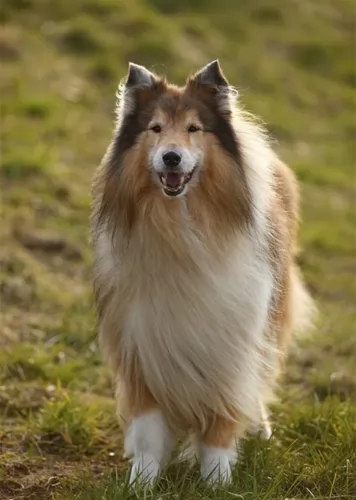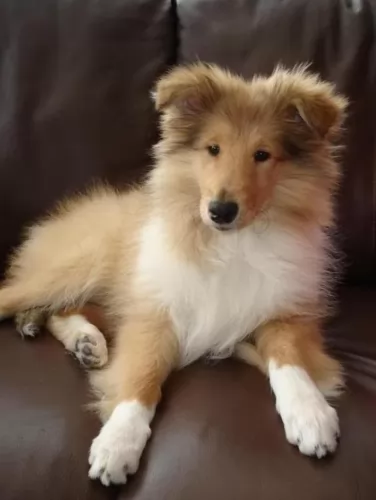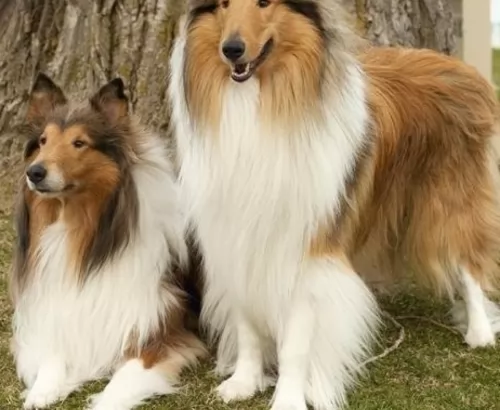 Collie is originated from United Kingdom but Beabull is originated from United States. Collie may grow 21 cm / 9 inches higher than Beabull. Collie may weigh 16 kg / 36 pounds more than Beabull. Collie may live 5 years more than Beabull. Collie may have more litter size than Beabull. Both Collie and Beabull requires Moderate Maintenance.
Collie is originated from United Kingdom but Beabull is originated from United States. Collie may grow 21 cm / 9 inches higher than Beabull. Collie may weigh 16 kg / 36 pounds more than Beabull. Collie may live 5 years more than Beabull. Collie may have more litter size than Beabull. Both Collie and Beabull requires Moderate Maintenance.
Basic Information
Group:
Herding dogs
Companion dog
undefined
United Kingdom
United States
Life Span:
14 - 16 Years
8 - 11 Years
Other Names:
Lassie, Scottish Collie, Rough Collie
None
Colors Available:
tan and black, White
white, brown brindle
Coat:
Long, dense and straight
have short, coarse hair that tends to shed a lot
Shedding:
Moderate, Seasonal
Constant
Temperament:
Affectionate, Alert, Cheerful, Courageous, Curious, Docile, Energetic, Friendly, Gentle, Independent, Intelligent, Lively, Loving, Loyal, Outgoing, Playful, Protective, Quiet, Responsive, Social, Sweet
Independent, Loving, Loyal, Playful
Grooming:
Moderate Maintenance
Moderate Maintenance
Trainability:
Easy
Moderate
New Owners Friendly:
Yes
Yes
History
 The Collie is a herding dog from Scotland and is also known by other names such as Rough Collie or Lassie Collie.
The Collie is a herding dog from Scotland and is also known by other names such as Rough Collie or Lassie Collie.
The first Collies used to be more in size as today’s Border Collies and they were also essentially black. Queen Victoria stepped in to save the Collie from obscurity, bringing some back to England where their popularity soared.
The looks started changing as they were bred and in 1860 they were shown at a dog show in Birmingham, England as ‘Scotch Sheep Dogs’.Later on the sable coat color was introduced.
In 1879 the first Collie was imported to the United States and a club for the dog breed was formed in 1886.
The Beabull is known as a designer breed rather than a purebred. The Beabull is a cross between a Beagle and an English Bulldog. This breed is a loving dog, playful and physically strong. They are independent and can be stubborn. Their origins are not well documented, but it is thought they were developed about 20 years ago. Although not recognized by the American Kennel Club because they are not purebred dogs
Description
 The modern Collie is a medium to large sized dog that stands at 51 – 61cm and weighs between 20 – 29kg. You could say that the popularity of the Collie grew because of the dog Lassie, a Rough Collie dog in the film ‘Lassie Come Home’. People who saw this film learned what a wonderful pet the dog could be.
The modern Collie is a medium to large sized dog that stands at 51 – 61cm and weighs between 20 – 29kg. You could say that the popularity of the Collie grew because of the dog Lassie, a Rough Collie dog in the film ‘Lassie Come Home’. People who saw this film learned what a wonderful pet the dog could be.
The Collie has two looks – the full coat which is known as the Rough Collie and the shorter coated Collie known as the Smooth variety. The coat comes in different colors but is essentially tri-colored in white, tan and black tips. The Collie has erect ears and a long, feathery tail.
Temperament:
Temperament of a dog is affected by a number of factors, including lifestyle of owners, heredity as well as whether the dog had training and socialization.
The Collie is a good-natured, friendly dog with no aggressiveness in him. He adapts well to city and country life, so long as he is with his human family, but he will need lots of exercise.
He will do well with training and socialization, turning into an even more splendid pet than he already is. He loves the children in the home and loves playing with them and watching over them. The Collie is intelligent and loyal and is easily trained.
The first generations of the Beabulls are a 50-50 mix, but most of the breed today are multigenerational dogs. This means a Beabull is mixed with another Beabull to try to create a purebred over time. Most of the Beabulls are a mixture and are very unpredictable in their looks and characteristics, depending upon which of the original parent breeds they favor most.
Many will retain the wrinkles, short legs, underbite and short tail of the Bulldog. Others will have the long droopy ears and long muzzles of the Beagle. Most will have coarse, short coats and shed quite a bit. They are medium to large depending upon which size Beagle is used in the crossing.
Characteristics
 Your Collie is an intelligent dog who will need physical exercise as well as mental stimulation too, otherwise he can develop some destructive behavior patterns that could be avoided just by seeing to his exercise needs.
Your Collie is an intelligent dog who will need physical exercise as well as mental stimulation too, otherwise he can develop some destructive behavior patterns that could be avoided just by seeing to his exercise needs.
He is easy to train and is a sensitive dog, wanting to learn and wanting to please.
A well trained Collie makes a wonderful pet. He is such a loyal dog that he will go to the ends of the earth for his owner, and guarantees to be every bit as affectionate, brave and loyal as the film-star dog, Lassie.
1.Children friendliness – Very good with children.
2.Special talents intelligent and many with a great sense of smell.
3.Adaptability – They can live anywhere in an apartment or a home with a yard.
4.Learning ability – Very intelligent but with a stubborn, independent streak that is inherent in both parental breeds.
Health Problems
 The Collie is a healthy dog breed generally, but just like with all other dogs, they are also prone to certain health conditions. It’s not to say that your Collie will get these diseases, but it can be beneficial to you and your pet’s health to be aware of them if you’re looking at the Collie as a pet.
The Collie is a healthy dog breed generally, but just like with all other dogs, they are also prone to certain health conditions. It’s not to say that your Collie will get these diseases, but it can be beneficial to you and your pet’s health to be aware of them if you’re looking at the Collie as a pet.
Collie Nose:
This is a condition where the skin of the nose peels and oozes and left untreated, it can be painful for your pet and could even lead to cancer.
Collie Eye Anomaly:
This is an inherited eye disease that can actually lead to blindness. When certain parts of the eye don't develop properly it can lead to CEA - a genetic disease found in Collies as well as other dog breeds. The disease is also known as Choroidal Hypoplasia and brings about changes and abnormalities in the eye.
Hip Dysplasia:
This is an abnormal formation of the hip socket and certainly dogs with hip dysplasia should never be bred as it can lead to pain and lameness.
Although most Beabulls will not have inherited health problems there are some issues they are all prone to:
• Bloat – can be fatal if not addressed immediately – inverted digestive organs.
• Hip Dysplasia – can cause lameness.
• Canine Disk Disease – can cause paralysis, loss of legs.
• Hypothyroidism
• Ear infections – keep them clean.
• Patellar Luxation – floating kneecaps – can cause lameness.
• Reverse Sneezing
Caring The Pet
Grooming:
 The Collie will need grooming because of his long hair, and you will need to brush it at least twice a week to rid it of loose hairs and to keep it free from tangles. This is especially important if you live in the country and he leads an active lifestyle running through fields.
The Collie will need grooming because of his long hair, and you will need to brush it at least twice a week to rid it of loose hairs and to keep it free from tangles. This is especially important if you live in the country and he leads an active lifestyle running through fields.
Keep a constant check on your Collie’s ears because dirt build-up can lead to an ear infection. Your vet can advise you on how to clean your dog’s ears. Make sure you have your Collie’s nails trimmed.
Diet:
To cater for your Collie’s size and activity levels, make sure to feed him good food that meets his nutritional needs. Protein is the most important nutritional need for dogs, and apart from feeding your dog quality kibble, protein should also come from raw, animal-based sources such as meat, fish and poultry.
You can also include some cooked brown rice, vegetables and cooked chicken to provide variety. Make sure he always has fresh, cool water available.
1.Feeding the puppy – Don’t overfeed due to tendency for obesity and don’t feed right before or after exercise due to threat of bloat. Feed 3-4 meals per day a total of 1.5 cups in a day.
2.Feeding the adult - Don’t overfeed due to tendency for obesity and don’t feed right before or after exercise due to threat of bloat. Feed 3-4 meals per day a total of 3 cups in a day.
3.Points for Good Health no hereditary issues
4. Games and Exercises – both the laziness of the Bulldog and the scent driven energy or the Beagle can be seen in the Beabull. They have short bursts of the Beagles hyperness. Enjoy playing fetch and participating in agility. They need a daily 45-60 minute walk.
Comparison with other breeds
- Collie vs English Bulldog - Breed Comparison
- Collie vs German Shepherd - Breed Comparison
- Collie vs Golden Retriever - Breed Comparison
- Collie vs Labrador Retriever - Breed Comparison
- Collie vs West Highland White Terrier - Breed Comparison
- Collie vs French Bulldog - Breed Comparison
- Collie vs Beagle - Breed Comparison
- Collie vs Yorkshire Terrier - Breed Comparison
- Collie vs Poodle - Breed Comparison
- Collie vs Rottweiler - Breed Comparison
- Collie vs Boxer - Breed Comparison
- Collie vs English Pointer - Breed Comparison
- Collie vs Siberian Husky - Breed Comparison
- Collie vs Doberman Pinscher - Breed Comparison
- Collie vs American Bully - Breed Comparison
- Collie vs Abruzzenhund - Breed Comparison
- Collie vs Affenpinscher - Breed Comparison
- Collie vs Afghan Hound - Breed Comparison
- Collie vs Aidi - Breed Comparison
- Collie vs Airedale Terrier - Breed Comparison
- Collie vs Akbash Dog - Breed Comparison
- Collie vs Akita - Breed Comparison
- Collie vs Africanis - Breed Comparison
- Collie vs Askal - Breed Comparison
- Collie vs Atlas Terrier - Breed Comparison
- Beabull vs English Bulldog - Breed Comparison
- Beabull vs German Shepherd - Breed Comparison
- Beabull vs Golden Retriever - Breed Comparison
- Beabull vs Labrador Retriever - Breed Comparison
- Beabull vs West Highland White Terrier - Breed Comparison
- Beabull vs French Bulldog - Breed Comparison
- Beabull vs Beagle - Breed Comparison
- Beabull vs Yorkshire Terrier - Breed Comparison
- Beabull vs Poodle - Breed Comparison
- Beabull vs Rottweiler - Breed Comparison
- Beabull vs Boxer - Breed Comparison
- Beabull vs English Pointer - Breed Comparison
- Beabull vs Siberian Husky - Breed Comparison
- Beabull vs Doberman Pinscher - Breed Comparison
- Beabull vs American Bully - Breed Comparison
- Beabull vs Abruzzenhund - Breed Comparison
- Beabull vs Affenpinscher - Breed Comparison
- Beabull vs Afghan Hound - Breed Comparison
- Beabull vs Aidi - Breed Comparison
- Beabull vs Airedale Terrier - Breed Comparison
- Beabull vs Akbash Dog - Breed Comparison
- Beabull vs Akita - Breed Comparison
- Beabull vs Africanis - Breed Comparison
- Beabull vs Askal - Breed Comparison
- Beabull vs Atlas Terrier - Breed Comparison
 Petzlover
Petzlover Collie is originated from United Kingdom but Beabull is originated from United States. Collie may grow 21 cm / 9 inches higher than Beabull. Collie may weigh 16 kg / 36 pounds more than Beabull. Collie may live 5 years more than Beabull. Collie may have more litter size than Beabull. Both Collie and Beabull requires Moderate Maintenance.
Collie is originated from United Kingdom but Beabull is originated from United States. Collie may grow 21 cm / 9 inches higher than Beabull. Collie may weigh 16 kg / 36 pounds more than Beabull. Collie may live 5 years more than Beabull. Collie may have more litter size than Beabull. Both Collie and Beabull requires Moderate Maintenance.  The Collie is a herding dog from Scotland and is also known by other names such as Rough Collie or Lassie Collie.
The Collie is a herding dog from Scotland and is also known by other names such as Rough Collie or Lassie Collie. The modern Collie is a medium to large sized dog that stands at 51 – 61cm and weighs between 20 – 29kg. You could say that the popularity of the Collie grew because of the dog Lassie, a Rough Collie dog in the film ‘Lassie Come Home’. People who saw this film learned what a wonderful pet the dog could be.
The modern Collie is a medium to large sized dog that stands at 51 – 61cm and weighs between 20 – 29kg. You could say that the popularity of the Collie grew because of the dog Lassie, a Rough Collie dog in the film ‘Lassie Come Home’. People who saw this film learned what a wonderful pet the dog could be. Your Collie is an intelligent dog who will need physical exercise as well as mental stimulation too, otherwise he can develop some destructive behavior patterns that could be avoided just by seeing to his exercise needs.
Your Collie is an intelligent dog who will need physical exercise as well as mental stimulation too, otherwise he can develop some destructive behavior patterns that could be avoided just by seeing to his exercise needs. The Collie is a healthy dog breed generally, but just like with all other dogs, they are also prone to certain health conditions. It’s not to say that your Collie will get these diseases, but it can be beneficial to you and your pet’s health to be aware of them if you’re looking at the Collie as a pet.
The Collie is a healthy dog breed generally, but just like with all other dogs, they are also prone to certain health conditions. It’s not to say that your Collie will get these diseases, but it can be beneficial to you and your pet’s health to be aware of them if you’re looking at the Collie as a pet. The Collie will need grooming because of his long hair, and you will need to brush it at least twice a week to rid it of loose hairs and to keep it free from tangles. This is especially important if you live in the country and he leads an active lifestyle running through fields.
The Collie will need grooming because of his long hair, and you will need to brush it at least twice a week to rid it of loose hairs and to keep it free from tangles. This is especially important if you live in the country and he leads an active lifestyle running through fields.